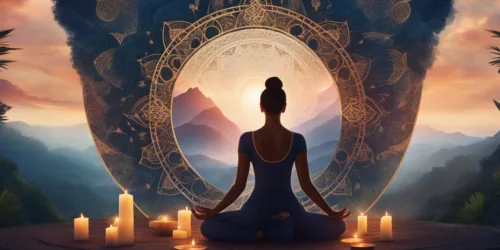Embrace Mindfulness in Calligraphy for Inner Peace
Welcome to our guide on embracing mindfulness in calligraphy for inner peace. Calligraphy, with its elegant and flowing strokes, not only allows us to create beautiful letterforms but also cultivates patience, creativity, and mindfulness. By immersing ourselves in the art of calligraphy, we can experience a deep connection to the present moment and find tranquility and self-expression. In this section, we will explore the techniques and benefits of practicing mindfulness through calligraphy, guiding you on your journey towards inner peace.
Key Takeaways:
- Calligraphy is a practice of decorative handwriting characterized by elegant and flowing strokes.
- Learning calligraphy cultivates patience, creativity, and mindfulness.
- Practicing mindfulness while creating calligraphy allows for a deep connection to the present moment and fosters tranquility and self-expression.
- Consistency and regular practice are key to mastering calligraphy.
- Calligraphy offers therapeutic benefits, enhances hand-eye coordination, and fosters an appreciation for the cultural and historical significance of the art form.
Mindfulness and Creativity in Calligraphy
Calligraphy, when combined with mindfulness, has the power to elevate creativity and unlock new levels of artistic expression. By incorporating mindfulness into your calligraphy practice, you can tap into a state of heightened awareness and fully immerse yourself in the process of creating each beautiful stroke. Mindful lettering involves slowing down and being fully present in the moment, allowing the brush strokes to flow naturally and rhythmically on the page. The deliberate and mindful approach to calligraphy helps you achieve a sense of ease and peacefulness, bringing greater depth and meaning to your artwork.
In the world of calligraphy, practicing mindfulness goes beyond the technical aspects of the craft. It encourages you to let go of perfectionism and negative self-judgment, allowing you to embrace imperfections as unique expressions of your individuality. By practicing mindful calligraphy, you can find joy in the act of creation itself, rather than solely focusing on the end result. This mindset enables you to explore different styles and scripts, providing a platform for personalization and self-expression.
Mindfulness in calligraphy can be likened to a form of meditation. As you engage in the deliberate and focused movements of each stroke, your mind becomes calm and centered. The rhythmic flow of the brush, the smooth connection between letters, and the serenity of the creative process nourish both your artistic spirit and your overall well-being.
“In mindful calligraphy, we let go of expectations and embrace the present moment, allowing our artistry to unfold naturally. The stillness we find in each stroke becomes a form of meditation, connecting us deeply to ourselves and our creative expression.”
The practice of mindfulness in calligraphy not only enhances your artistic abilities but also provides a pathway to self-discovery and personal growth. It encourages you to be fully present in each letter, cultivating a deep sense of appreciation for the beauty and intricacy of the art form. By infusing mindfulness into your calligraphic journey, you can unlock your creative potential, cultivate a sense of inner peace, and create works of art that truly reflect your soul.
The Power of Mindful Calligraphy in Cultivating Creativity
Mindfulness allows you to tap into your inner wellspring of creativity, guiding your brush and empowering your artistic expression. By practicing mindful calligraphy, you embark on a journey of self-exploration, embracing the present moment and transcending the boundaries of what you thought was possible.
| Mindfulness Benefits in Calligraphy | How It Enhances Creativity |
|---|---|
| 1. Enhanced focus and concentration | Increased attention to detail and subtleties, resulting in more refined and intricate letterforms. |
| 2. Greater awareness of body and breath | Improved control and fluidity in brush movements, creating harmonious and flowing strokes. |
| 3. Increased patience and acceptance | Embracing imperfections as part of the creative process, leading to innovative and unique artistic styles. |
| 4. Heightened sense of joy and curiosity | Exploring diverse scripts and lettering styles, fostering experimentation and opening new creative possibilities. |
Through the mindful practice of calligraphy, you can unlock your innate creativity, creating works of art that not only inspire others but also serve as timeless reminders of your own personal journey.
The Power of Mindful Calligraphy in Combating Stress
Mindful calligraphy is a powerful practice that can have a profound impact on our well-being. By engaging in the mindful creation of beautiful letterforms through deliberate and intentional strokes, we can experience a sense of calm and relaxation.
Calligraphy provides us with a means to escape from the noise and chaos of our everyday lives, allowing us to focus our attention on the present moment. This redirection of our thoughts from stressors to the act of calligraphy promotes a state of mindfulness, helping us find inner peace.
When we practice mindful calligraphy, we are not only engaging in a creative process but also utilizing a therapeutic tool for stress reduction. By bringing our full awareness to each stroke and character, we can decrease our stress levels and enhance our concentration. The act of mindfully creating beautiful and meaningful artwork also provides us with a sense of accomplishment, which further contributes to our overall well-being.
Mindfulness in calligraphy allows us to express ourselves, giving us an outlet for self-care and self-expression. It provides a respite from the demands and pressures of daily life, enabling us to recharge and rejuvenate. The combination of mindful practices and calligraphy becomes a powerful means to relieve stress and foster a sense of inner peace.
FAQ
What is calligraphy?
Calligraphy is the practice of decorative handwriting characterized by elegant and flowing strokes.
What are the essential tools for calligraphy?
The essential tools for calligraphy include calligraphy pens, ink, paper, and a steady hand.
How do I start learning calligraphy?
To embark on a calligraphy journey, you need to assemble the necessary materials, immerse yourself in knowledge through online tutorials and books, dedicate consistent practice, seek guidance and feedback from experienced calligraphers, and embrace the art of mindfulness.
What are the benefits of practicing mindfulness in calligraphy?
Practicing mindfulness while creating calligraphy allows for a deep connection to the present moment and fosters tranquility and self-expression. It also enhances creativity, promotes relaxation, decreases stress levels, enhances concentration, and offers a respite from the demands of daily life.
How can mindfulness enhance creativity in calligraphy?
Mindful lettering involves slowing down and being fully present in the moment, allowing the brush strokes to flow naturally and rhythmically on the page. Through mindful brush strokes, the calligrapher can achieve a sense of ease and peacefulness, fostering greater artistic expression and experimentation with different styles and scripts.
Can mindful calligraphy help with stress reduction?
Yes, mindful calligraphy has the power to combat stress and promote overall well-being. The act of creating beautiful letterforms through mindful strokes can bring a sense of calm and relaxation. By practicing mindful calligraphy, individuals can experience a decrease in stress levels, enhanced concentration, and a sense of accomplishment.






